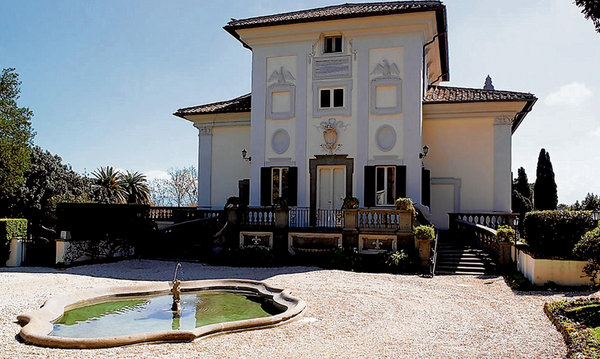By Paddy Agnew
Irish Times
July 16, 2011
http://www.irishtimes.com/newspaper/ireland/2011/0716/1224300820699.html
 |
| The Irish Embassy to the Vatican, the Villa Spada. Bought for $150,000 in December 1946, it is now worth many millions. |
Holy See takes dim view of countries that only have an ambassador to the Italian state
RATIONALISING Ireland’s diplomatic service in Rome could save the taxpayer ˆ2.4 million.
That sum would be saved if Ireland moved its embassy to the Italian state to the site of its embassy to the Holy See, and in turn moved its Holy See ambassador to a base in an existing embassy in a neighbouring country.
Taoiseach Enda Kenny indicated this week in the wake of the Cloyne report that the Government might close the Irish Embassy to the Holy See.
First-time Irish visitors to Rome, on discovering that the Irish state runs two diplomatic missions in the Eternal City, often express surprise.
However, the point about the dual missions in Rome (and many other countries have two embassies here) is that they owe their existence to the Holy See’s desire to separate itself from the Italian state. It is the Holy See which refuses to accept an ambassador who is working out of the same building as the ambassador to Italy.
To some extent, the question goes back to the first World War, when there was only one national embassy in Rome. When both Austria and Germany, then at war with Italy, withdrew their diplomatic representation, the Holy See found itself without German or Austrian interlocutors.
In its finely tuned Jesuitical thinking, the Holy See objected to ambassadors being withdrawn because, while Italy was at war with Austria and Germany, the Holy See certainly was not.
The question is a delicate one given that the Holy See mounts a zealous guard on the independence of its 100-acre, landlocked sovereign city-state enclave in the heart of the Eternal City. Put simply, if you want to show some proper respect and courtesy to the Holy See, then you had better open up an embassy to the Holy See.
Countries which opt not to have a separate Vatican embassy usually end up “tagging on” Holy See responsibilities to their ambassador in a neighbouring country such as France, Malta or Switzerland.
The Holy See takes a dim view of this and the ambassador in question is very much a second-class citizen on the Vatican diplomatic circuit. All of this was something the post-war Irish ambassador to the Holy See, Joseph Walshe, understood all too clearly.
He inherited an embassy close to the central railway station where lorries, trams and trolley buses trundled by on a 24-hour basis. Frustrated with this accommodation, Walshe in 1946 reported to Dublin that Ireland really should upgrade its quarters, quoting the opinion of the US special representative, Myron Taylor, who said: “Ireland has a very special position in the Catholic world and in Rome and should have an embassy worthy of Ireland.”
Given the green light to find such a site, Walshe came up with the goods in the shape of the splendid 17th-century Villa Spada on the Gianicolo hill overlooking Rome.
This is and was a magnificent building which has written some intriguing chapters in Italian history, given that Garibaldi had used it briefly as his HQ in 1849 while in more recent years it was home to the Agnelli (Fiat) family during the second World War.
Bought for $150,000 in December 1946, the Villa Spada is now worth many millions. The villa functions not just as the residence of the Irish ambassador to the Holy See (that position is currently vacant given the recent retirement of Noel Fahey) but also houses the mission’s offices.
If it was decided to reduce the Irish missions in Rome to just one house, then logic would suggest that the embassy to the Italian state move into the Villa Spada since it currently rents its Rome embassy.
In answer to a parliamentary question in November 2009, then minister for foreign affairs Micheal Martin said in 2008 the two embassies cost ˆ2.4 million (Italian state) and ˆ900,000 (Holy See). So clearly, more is to be gained from relocating the embassy to the Italian state.
This saving, however, would come at a price. Not only would it strain relations with the Holy See, but Ireland would be cutting itself off from one of the world’s best “listening posts”, given that the Vatican has an unparalleled worldwide network of contacts, intelligence and information.
Any original material on these pages is copyright © BishopAccountability.org 2004. Reproduce freely with attribution.